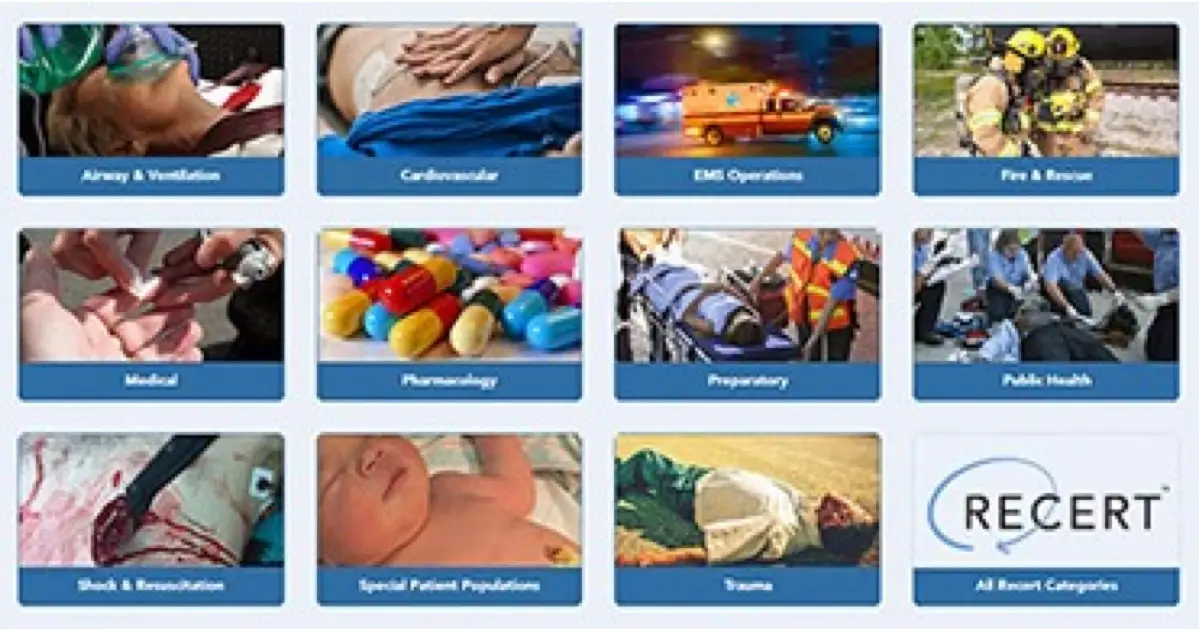Recert Continues to Grow!
Our Recert team is pleased to announce the availability of six new courses focused on topics ranging from critical care to spinal cord injury and neurogenic shock.
Learn more about these unique courses today.
Critical Care: Blood Product Administration (ALS Edition)
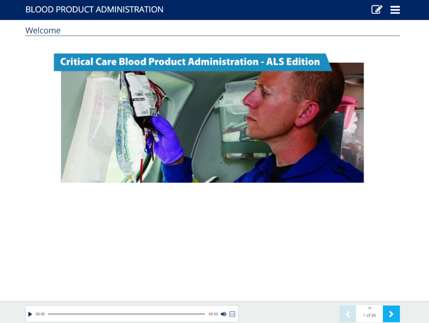 The decision to give a transfusion to a patient during a critical care transport is more complex than the administration of blood in the hospital setting. The urgency of the transfusion, the out-of-hospital time, the availability of the blood products, type-and-crossmatch information, and the appropriate transport and care of the blood product must all be considered. A risk-benefit analysis of the “right treatment for the right patient at the right time” must be conducted as well.
The decision to give a transfusion to a patient during a critical care transport is more complex than the administration of blood in the hospital setting. The urgency of the transfusion, the out-of-hospital time, the availability of the blood products, type-and-crossmatch information, and the appropriate transport and care of the blood product must all be considered. A risk-benefit analysis of the “right treatment for the right patient at the right time” must be conducted as well.
Critical Care: Pacemakers (ALS Edition)
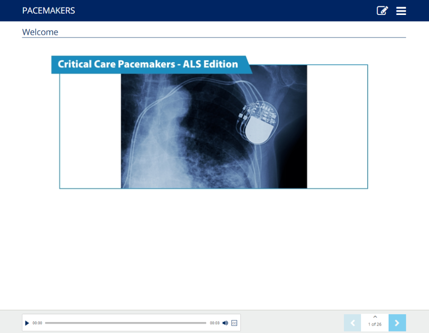 Critical care transport professionals routinely encounter patients with cardiac arrhythmias. Traditionally, cardiac arrhythmias have been treated pharmacologically. Unfortunately, cardioactive medications often have side effects that can reduce the patient’s quality of life; in some cases, they may be ineffective, even when prescribed appropriately and taken with good compliance. The tremendous evolution of pacing technology has allowed more types of arrhythmias to be treated electrically, often with little to no patient awareness at the time electrical therapy is being delivered.
Critical care transport professionals routinely encounter patients with cardiac arrhythmias. Traditionally, cardiac arrhythmias have been treated pharmacologically. Unfortunately, cardioactive medications often have side effects that can reduce the patient’s quality of life; in some cases, they may be ineffective, even when prescribed appropriately and taken with good compliance. The tremendous evolution of pacing technology has allowed more types of arrhythmias to be treated electrically, often with little to no patient awareness at the time electrical therapy is being delivered.
Get Started Today!
Critical Care: Pharmacology (ALS Edition)
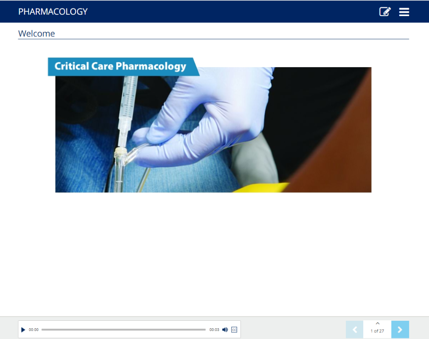 Pharmacology plays a significant role in prehospital and critical care medicine and is often an essential component of patient care and transport. Critical care transport professionals (CCTPs) need an enhanced understanding of all aspects of pharmacology to provide optimal patient care without causing further patient injury or death.
Pharmacology plays a significant role in prehospital and critical care medicine and is often an essential component of patient care and transport. Critical care transport professionals (CCTPs) need an enhanced understanding of all aspects of pharmacology to provide optimal patient care without causing further patient injury or death.
Get Started Today!
The ABCs of LGBT: Creating a Positive Space in the Ambulance (BLS/ALS Edition)
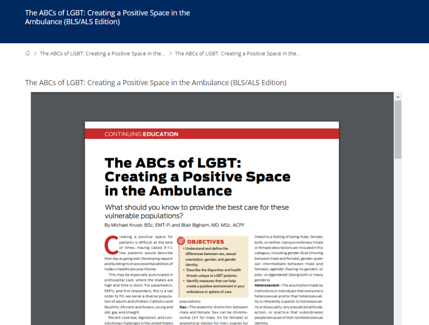 With 4% to 12% of the population self-identifying as LGBT, you’ve certainly already cared for an LGBT person in the back of your ambulance. While some healthcare workers turn a blind eye to this population, there are some unique healthcare needs to consider, and there remain challenges in ensuring LGBT patients feel comfortable, accepted, and safe.
With 4% to 12% of the population self-identifying as LGBT, you’ve certainly already cared for an LGBT person in the back of your ambulance. While some healthcare workers turn a blind eye to this population, there are some unique healthcare needs to consider, and there remain challenges in ensuring LGBT patients feel comfortable, accepted, and safe.
This article defines terms relevant to this patient population, provides tips on communicating with a transgendered person, details health disparities compared to non-LGBT people, and discusses healthcare rights for LGBT persons. It also offers suggestions on how to create a positive space for this population in the ambulance, interviewing LGBT patients, and how to chart or report transgender people.
Get Started Today!
NAEMT 2018 National Survey on Mobile Integrated Healthcare and Community Paramedicine
(BLS/ALS Edition)
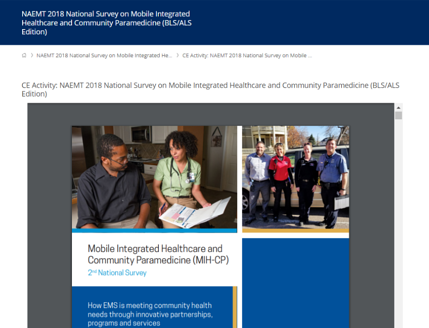 It’s been well documented that many of the calls placed to 911 are not life-threatening emergencies. That’s not to say people aren’t sick or suffering. Research has shown that these patients would be better served somewhere other than emergency departments, yet EMS has traditionally been limited in what its practitioners could do to help patients address their complex issues and get on a path to better health.
It’s been well documented that many of the calls placed to 911 are not life-threatening emergencies. That’s not to say people aren’t sick or suffering. Research has shown that these patients would be better served somewhere other than emergency departments, yet EMS has traditionally been limited in what its practitioners could do to help patients address their complex issues and get on a path to better health.
Over a decade ago, forward-thinking EMS agencies began developing new programs designed to meet community health needs, in accordance with the Institute for Healthcare Improvement’s Triple Aim: improved patient experience of care, improved population health and reduced per capita cost of healthcare. Called mobile integrated healthcare or community paramedicine (MIH-CP), these programs identified gaps in the healthcare available in the community and put EMS practitioners to work in addressing those problems. Despite significant hurdles to implementing and financially sustaining these programs, many EMS professionals embraced MIH-CP with enthusiasm.
Get Started Today!
Spinal Cord Injury and Neurogenic Shock (ALS Edition)
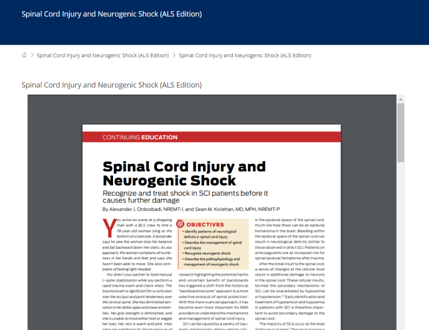 In this article, practitioners learn about spinal cord injury (SCI), which is devastating to patients. Given the lifelong disability associated with these injuries and fear that neurological injury may be exacerbated during transport, immobilization of the spine using cervical collars and backboards has long been ingrained into EMS training and protocols. However, recent research highlighting the potential harms and uncertain benefit of backboards has triggered a shift from the historical “backboard everyone” approach to a more selective protocol of spinal protection.
In this article, practitioners learn about spinal cord injury (SCI), which is devastating to patients. Given the lifelong disability associated with these injuries and fear that neurological injury may be exacerbated during transport, immobilization of the spine using cervical collars and backboards has long been ingrained into EMS training and protocols. However, recent research highlighting the potential harms and uncertain benefit of backboards has triggered a shift from the historical “backboard everyone” approach to a more selective protocol of spinal protection.
With this more nuanced approach, it has become even more important for EMS providers to understand the mechanisms and management of spinal cord injury. This article discusses spinal cord anatomy, complete transection, Brown-Séquard, anterior cord, and central cord syndromes, assessment, managing complications, types of shock in trauma, and treatment of neurogenic shock.
Get Started Today!
Visit www.recert.com to learn more, create your free profile, or a request a demo today.
